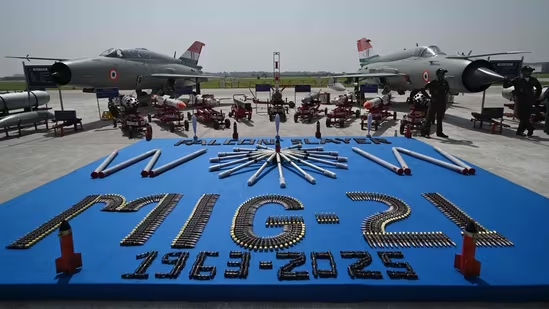The Indian Air Force bids farewell to the iconic MiG-21 in a final flypast at Chandigarh. After 63 years of service, the legendary jets are decommissioned.

Chandigarh Witnesses the Final Flight of IAF’s MiG-21 After 63 Years
On 26 September 2025, the Indian Air Force (IAF) marked the end of a remarkable era as the MiG-21 fighter jets took to the skies for one last sortie over Chandigarh before being officially decommissioned. First inducted into service in 1963, these venerable aircraft have borne witness to many of India’s most defining military moments. With their retirement, the IAF says goodbye to a legend that has shaped the country’s aerial capability for over six decades.
The Storied Legacy of the MiG-21 in India
When the MiG-21 entered Indian service in 1963, it represented a leap forward — a supersonic interceptor capable of securing the skies. Over time, India inducted many variants, culminating in the upgraded MiG-21 Bison model, retrofitted with modern avionics and weapons systems.
These jets saw action in multiple conflicts, including:
- The 1965 Indo-Pakistan War
- The 1971 Bangladesh Liberation War
- The Kargil conflict of 1999
- The 2019 Balakot air strikes
Throughout, the MiG-21 remained a mainstay of India’s air defense.
But for all its service and valor, the MiG-21 was not without controversy. Over the years, it earned a reputation (sometimes unfairly so) as a “flying coffin” due to its relatively high accident rate, particularly with aging airframes and engine issues.
The Final Ceremony at Chandigarh
The decommissioning ceremony was held at Chandigarh Air Force Station, the very location where the MiG-21 jets were first inducted in 1963.
- A flypast of the remaining MiG-21s (notably from No. 23 Squadron, “Panthers”) honored the aircraft’s legacy.
- A water cannon salute was rendered as the jets landed, symbolizing respect and closure.
- Air Chief Marshal Amar Preet Singh flew the last official sortie, marking a symbolic end to active operations.
- Squadron Leader Priya Sharma became the last woman pilot to fly a MiG-21, signifying not just an end, but also evolution in roles.
The ceremony drew top defence dignitaries, including the Defence Minister, chiefs of the Army and Navy, CDS, and former IAF chiefs.
The Challenges Behind Their Longevity
That the MiG-21 lasted 63 years is no small feat, but it also underscores the challenges India faced in modernizing its fleet.
- Delay in replacements: Successor aircraft, including the indigenous Tejas and imported fighters, faced production, procurement, and delivery delays, which pushed back the
- Maintenance burden: Keeping older airframes airworthy required increasing maintenance effort, upgrades, and spare parts management.
- Safety concerns: The aging engines and systems were prone to malfunctions, adding risk to every flight. Over 500 MiG-21s are reported to have crashed in India’s history, with over 170 pilot fatalities.
- Squadron strength gap: Even now, the IAF operates fewer squadrons than its sanctioned strength. With the MiG-21 retirement, the force’s ability to maintain coverage across its fronts is tested.
What Comes After — The Road Ahead for IAF
With the MiG-21 retired, the IAF turns to a new generation of aircraft to carry its legacy forward.
- Tejas Mk1A and Mk2: The indigenous Light Combat Aircraft is expected to be a backbone in the new fleet.
- Foreign procurements: Deals for multimode fighters from global defence firms are in the works to bridge capability gaps.
- Next-gen platforms: The IAF is also counting on future platforms like the Advanced Medium Combat Aircraft (AMCA) to deliver stealth and high performance capabilities.
- Integrated defence posture: While new fighters are inducted, the IAF will lean more on integrated air-defense systems, drones, and networked warfare to maintain deterrence.
Farewell to a Legend — Legacy and Reflections
The MiG-21 may have flown its last official sortie, but its impact will echo through history. Pilots who flew it often speak of the bond between man and machine — pushing the jet to high speeds, mastering its quirks, and carrying out missions with courage.
As one veteran put it, this was not just a plane; it was a mentor in the sky — demanding, exacting, but transformative.
Today, as India looks toward a modern aerial future, the curtain closes on an era that defined much of the country’s post-independence air power. The MiG-21’s last flight from Chandigarh is more than a ceremonial goodbye — it is a salute to generations of pilots, engineers, and maintenance crews who kept her flying.
READ ALSO………Car Catches Fire Inside Mumbai Coastal Road Tunnel – 1 Hour Traffic Disruption 2025














 Categories
Categories








